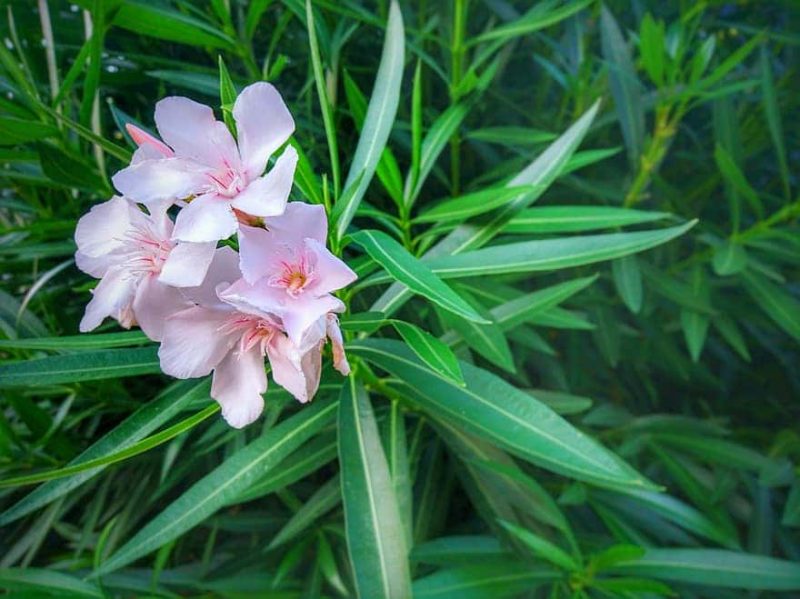You only need to learn two steps to learn how to grow oleander from cuttings. Please take comfort in the fact that oleanders are fast-growing plants, which makes their propagation relatively smooth. However, you still want to ensure that you’re providing the ideal conditions for the cuttings to encourage rapid root development.
For example, you can easily maintain the environment for the oleander cuttings in the greenhouse. You can prevent temperature and humidity fluctuations that can cause a drawback in rooting. As a bonus, the greenhouse also protects from the outdoor climate to keep the cuttings from getting damaged.

How To Propagate Oleander From Cuttings
The best time to grow oleander from cuttings is after it has finished its vegetative phase in spring. This way, you can grow healthy plants that you can transfer to the ground by fall. However, you can also prepare the cuttings at other times in the year, depending on your climate or if you have a greenhouse.
More so, don’t forget to wear protective clothing such as gloves and goggles to keep yourself safe from the poisonous sap of oleander. Don’t let kids or pets in the area to prevent them from accidentally making contact with the sap. You don’t have to be intimidated in propagating the poisonous oleander, but precaution and presence of mind are crucial.
Step #1. Collecting and preparing cuttings
To start oleander from cuttings, you want to prepare the plant for cutting collection. Remember that it should be healthy so that it won’t get stressed afterward. Using sharp and sterile shears, cut a 6-inch section from a branch with no disease or damage.
More so, the best sections for rooting are those that have not grown flowers but also not too woody. The cutting should have at least two leaf nodes to ensure rooting. Then, remove the lower leaves, so they don’t rot when you root the cuttings.
It would help if you also trimmed some of the leaves so the oleander can focus its energy on root development. Speaking of which, some gardeners recommend slicing the bottom of the cutting to increase the surface area. As a result, the cutting can absorb the necessary nutrients easier for optimal root formation.
Step #2. Rooting and transplanting
The easiest way to encourage root development of oleander cuttings is in water. A glass with at least 3 inches of water should suffice so that you can ensure that the water will submerge the end of the cutting. At this point, you can expect sprouting after a few weeks, but don’t forget to replace the water every two days to keep it clean.
Before planting, mist the medium to help the roots and then place them somewhere bright to encourage growth. Always maintain soil moisture, but never to the point that the cuttings sit in a soggy medium. After a year, you can replant the cutting in a bigger container or outdoors and fertilize at the beginning of spring and fall.
However, it’s important to emphasize the need to be gentle in handling the cuttings to avoid damaging their roots. If you skipped rooting in water, you could also dip the cutting in rooting hormone instead before planting in soil. Then, schedule the transplanting in spring after the danger of frost and protect the plants in the greenhouse for the meantime in winter.
How To Maintain Oleander
Oleander plants have many uses, but remember that they will thrive best if the environment is ideal. You want to provide full sun and protection from extreme conditions, so consider using a greenhouse if necessary. Above all, oleanders require well-draining soil, but they will survive drought once established.
If your region experiences harsh climates, you risk damaging the foliage of oleanders. However, it’s common for oleanders to recover in spring if the roots stay protected. You also want to avoid cutting at the end of the fall because you risk damaging new growth once frost starts.
You can train oleander into a small tree if you prefer it to the typical mound and large shape. Regardless, remember to prune at the beginning of spring to help them thrive and encourage more prolonged bloom. It’s also common to cut the tips after the flowering season to help oleander develop more branches.
Conclusion
One of the best propagation methods for oleander plants is by using cuttings. You can even learn how to grow oleander from cuttings in two easy steps, and you’ll be ready with a healthy plant for planting in no time. Much like with growing other plants from cuttings, select a healthy parent plant, and take a section with two leaf nodes.
Remove the lower leaves and root the cutting in a glass of water. Once you have two-inch roots, transplant them in soil and place them in the greenhouse for stable conditions and protection against challenging weather. After a year, you can transplant in a bigger container or area and fertilize in spring and fall.
In general, a well-draining area with full sun is optimal for oleanders. You can grow it as is, which is a mound, but it’s also possible to train it into a small tree. And if you want to extend the blooming season or encourage branching, oleanders respond well to pruning.
